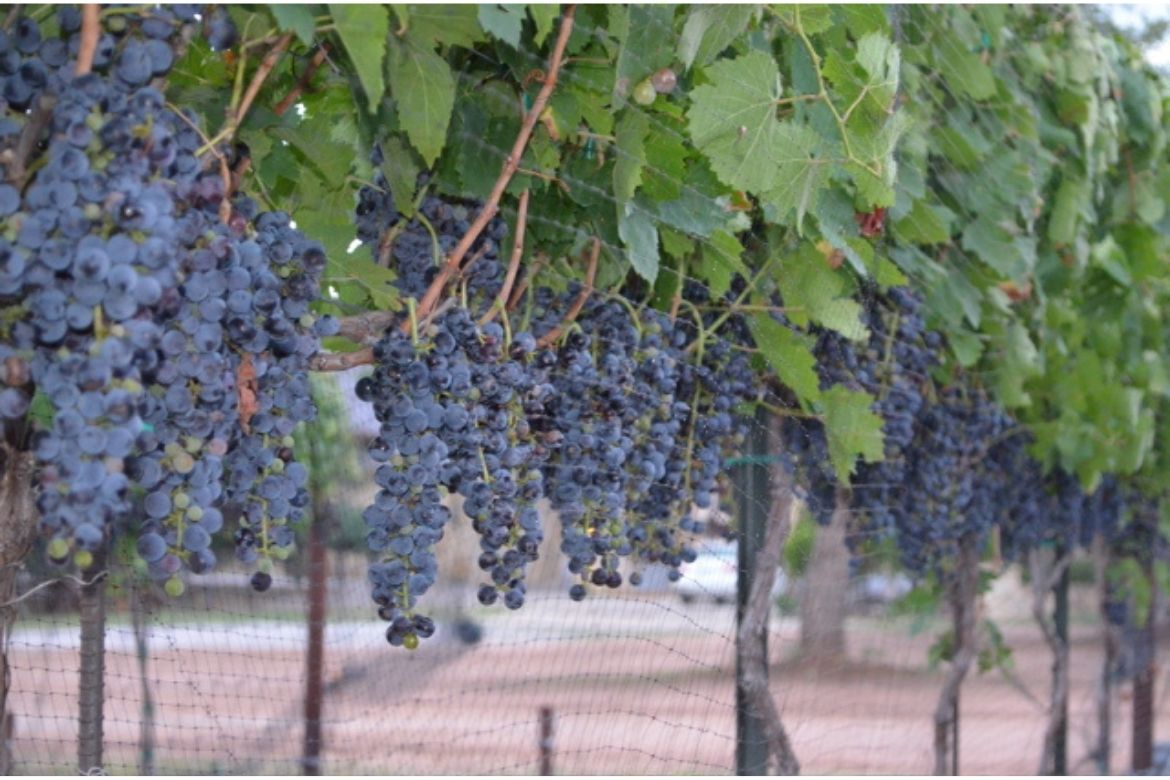Kay Ledbetter, Texas A&M AgriLife Extension
The Texas High Plains is home to 80% of the grapes that fuel a burgeoning Texas wine industry. But the High Plains is also home to some formidable obstacles to grape growing, which is why Texas A&M AgriLife has focused research initiatives to help growers find solutions.
The viticulture and enology programs are based in the Department of Horticultural Sciences within the Texas A&M College of Agriculture and Life Sciences. The programs include nine experts working across the state with the Texas A&M AgriLife Extension Service. Together, these experts generate and disseminate the critical science-based knowledge needed to grow grapes for Texas’ burgeoning wine industry, particularly in the High Plains.
“The mission of the Department of Horticultural Sciences at Texas A&M University is to address the needs of the state’s horticulture industry,” said department head Amit Dhingra. “Viticulture in the entire state is a priority area for us, and we are committed to supporting the growth of the Texas wine industry.”
From France To Texas And Back Again
One of the people supporting that industry is Pierre Helwi, an assistant professor in the horticulture department and AgriLife Extension viticulture specialist based in Lubbock. Helwi came from Cognac, France, six years ago and has helped build a program concentrating on applied research to meet growers’ needs.
“People are looking for science-driven data and real results from research projects,” Helwi said. “They trust us, and they want to hear more from us.”
That trust was evident, he said, after more than 200 people attended the Viticulture and Enology Research Symposium hosted by the department on the Texas A&M campus this past December.
“This was our first year, and we were surprised by the number of people who came to this symposium. It was amazing.”
Helwi is returning to France, but Dhingra said the department’s team of viticulturists are dedicated to the High Plains, the research driven by producer needs, and the Texas industry. And that won’t change.
“In his six years in the Lubbock area, Dr. Helwi established a vibrant applied research program, and the department is committed to continuing on his work and develop new research-driven solutions for the needs of our wine industry,” Dhingra said.
Building A Research Program
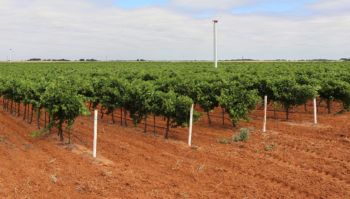
Larry Stein, Department of Horticultural Sciences associate department head and AgriLife Extension horticulturist stationed in Uvalde, said Helwi overcame many challenges when he moved to Texas.
“I would say adjusting to the Texas High Plains American Viticulture Area (AVA) was probably the hardest, as one day it is freezing and the next day it is hailing,” Stein said. “Pierre came in as a program specialist and quickly interacted with the growers to determine their needs. He formed great relationships with the growers, and they appreciated his efforts.”
Helwi said he started his research project mainly to answer some big questions related to the wine industry in West Texas and the High Plains. “That’s how I chose what research projects to focus on – what issues were growers facing?”
Daniel Hillin, also a member of the department’s viticulture staff and an AgriLife Extension viticulture program specialist stationed in Lubbock, said the wine industry is growing fast in Texas, as is the demand for High Plains grapes used in Texas wines.
“The amount and type of research we do are all based on grower needs in this region,” Hillin said. “The industry is definitely driving our research and educational programs.”
A major issue in the Texas High Plains is winter injury. The labor shortage is another problem. There’s also variability of the crop within a single vineyard. Throughout the year, challenging weather brings problems, including issues related to winter freeze, spring frost and summer hailstorms.
Hail Netting
To battle against the relentless hail that falls in spring and summer storms, Helwi teamed up with colleagues to determine if hail-preventive netting affected the leaf gas exchange, fruit ripening and fruit quality. On this project, Helwi collaborated with Thayne Montague, Ph.D., Texas Tech University associate professor of horticulture with a joint appointment to Texas A&M AgriLife Research, and Kenneth Ruland, also at Texas Tech.
After all the testing, he said they found no differences at harvest on fruit production or quality between vines covered with hail netting and those not covered, thus allowing producers an effective means to combat hail damage in the High Plains.
Bud Cold Hardiness
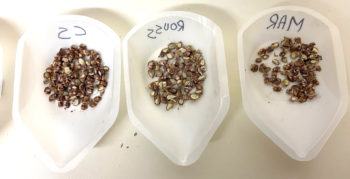
Monitoring bud cold hardiness in real time was another big research project Helwi started in 2019 in collaboration with the High Plains Winegrowers Association. The association funded half of the equipment, and the Department of Horticultural Sciences funded the rest.
“This project will allow us to determine which varieties are tolerant to winter cold temperatures and which are sensitive, allowing a better cultivar selection by the growers,” Helwi said. The winter of 2021/2022 was the first year of data collection, and that needs to be continued and fine-tuned during the upcoming years.
Hillin said they used differential thermal analysis to determine the lethal temperature for the bud tissue of each variety tested. Those temperatures were then cross-referenced with real-time weather data. In this way, the team was able to give the most accurate information to growers about which varieties may be more susceptible to upcoming freezing conditions. Five bud varieties were sampled every week between December 2020 and May 2021.
“We were able to provide real-time data to the growers that two varieties sampled had indeed shown a higher degree of possible bud damage, which was later confirmed by sampling multiple vineyards across the High Plains AVA,” Hillin said.
In 2021, that number was increased to 15 varieties, sampling every two weeks to allow for the increase in the number of varieties. Overall, the data demonstrated a lower degree of possible bud damage across all of the varieties sampled.
“We plan to continue this project and further increase the number of sampled varieties to provide more information to growers about possible winter injury in the future,” Hillin said.
All of this data is currently published on the Texas Viticulture and Enology Facebook page.
Acidifying With Green Juice
Another project looked at the use of verjus, or green juice, from grapes that are still unripe at harvest, caused by an uneven growing pattern across vineyards. Helwi said instead of throwing these grapes away, the Texas A&M AgriLife team determined those grapes could be used to make verjus and used as an acidifier for the Texas wine, which can have too-low levels of acid, or high pH.
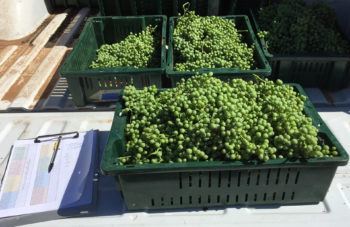
“We are always working on a tactic or techniques to correct the wine pH or acidity,” he said. “Growers or winemakers use tartaric acids typically. So, we said, why don’t we produce verjus instead of letting those grapes be wasted? Why would we throw them away when we can produce something that we can use as an acidifier for the final wine instead of tartaric acid?”
The Texas Department of Agriculture funded the project and Helwi was joined by Andreea Botezatu, AgriLife Extension enology specialist, Bryan-College Station; Justin Scheiner, AgriLife Extension state viticulturist, Bryan-College Station; and Hillin. Hillin, Botezatu and Scheiner will continue that work for the next few years. Collaborating on the project are Charlie Hall, professor in the Department of Horticultural Sciences, Bryan-College Station, and Xiaofen Du, Texas Woman’s University assistant professor and flavor chemist.
Crop Load And Fruit Via Mechanical Harvester
“We found that vines with the lowest crop load had a faster berry-ripening rate and wines with higher alcohol and pH,” Helwi said.
So, Helwi led research that studied the effects of fruit thinning — reducing the number of grapes on a vine — using a mechanical harvester 30 days post-bloom. The project was initiated to determine if the mechanical fruit thinning affected vine crop load that, in consequence, influenced berry and wine quality.
“This time- and cost-friendly technique appeared to be a tool for grape growers to manipulate yield to achieve desired berry and wine chemistry,” he said.
Education To Meet The Needs Of A Growing Industry
Helwi and Hillin said when it comes to educational programs, they are aiming at a knowledgeable crowd. The growth of the wine industry in the High Plains region is primarily driven by people who are already experienced with viticulture or are established and seasoned vineyard owners who are expanding.
“The growers in these regions are a tight-knit group, and they network and share information and experiences,” Hillin said. “We have some of the best growers in the state. They meet and exceed some of the greatest challenges every year.”
As with everything in today’s market, the cost of planting a new acre of grapes is significantly increased, he said, and AgriLife Extension provides an educational role on science-based best management practices for this region to help with efficiencies and offer potential new growers a realistic idea of what to expect.
“We offer educational material in multiple forms, from in-person workshops to virtual events, to hands-on demonstrations to research projects across the entire state,” Hillin said. “We also interact with industry personnel to provide up-to-date, science-based, educational presentations. We give industry updates to lawmakers and interact with other Extension personnel at the national level.”
“We also offer onsite visits; we are the only university in Texas that offers this service,” he said.
Many of the AgriLife Extension projects are highlighted at the annual Newsome Grape Day. This year’s event is set for 8 a.m. to 4 p.m. April 29 in Plains. The event draws growers, wineries and industry professionals from all over Texas and the country.
Wine And Grape Growing Future In The High Plains
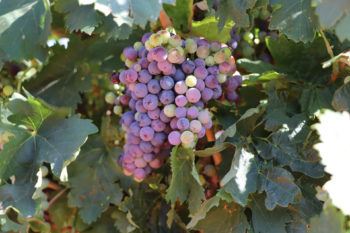
There’s big potential for Texas wines, Helwi said, especially now that they are more present on the world market.
“Texas wine is getting a lot of attention and gaining a lot of gold medals in international competition,” he said. “This is because of the improvement of the quality and how we grow grapes. At Texas A&M, we are offering a lot of great educational programs and onsite visits to help growers produce better grapes and better wines. We are also conducting the research needed to answer their questions.”
Helwi said that in the past six years, “I think the quality of our education programs and presence with the growers in the vineyards helped a lot, mainly in their selection of varieties, disease identification and best management practices.”
It did help, he said, that the team was working with experienced growers who found the AgriLife Extension specialists very helpful, mainly because they were conducting important research for this region and delivering science-based data.
“This was very appreciated,” Helwi said. “Everything we say is science based, and we were also present next to prospective growers and new growers to guide them through the establishment of the vineyards. I think growers really appreciate that.”
Helwi estimates that the number of wineries in the High Plains has doubled in the last few years. And, of course, there’s also more demand for High Plains’ grapes for the growing Texas industry.
Why?
“Because there’s good potential here,” Helwi said. “The grapes are great quality, and consumers ask for Texas wine.”



























